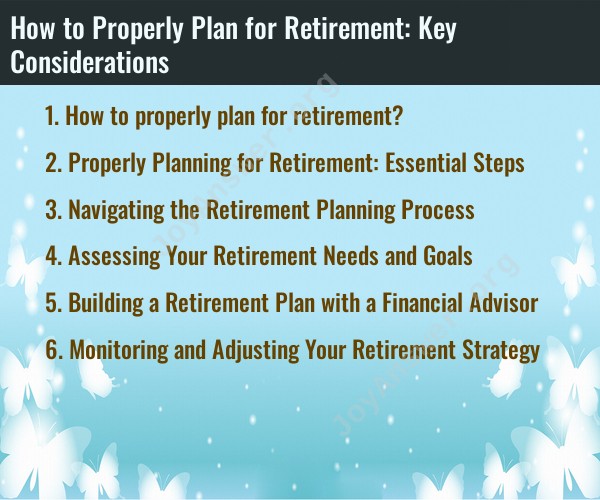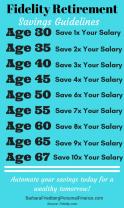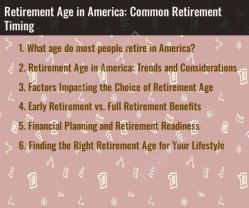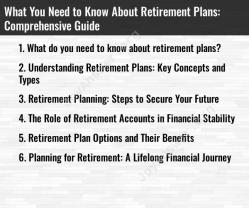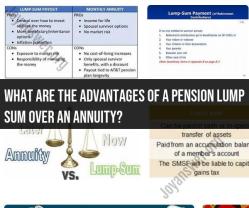How to properly plan for retirement?
Properly planning for retirement is essential to ensure financial security and a comfortable lifestyle during your post-working years. Here are key considerations and steps to help you create a comprehensive retirement plan:
Set Retirement Goals:
- Determine when you want to retire and the lifestyle you aspire to have during retirement. Consider factors like where you want to live, travel plans, healthcare needs, and any hobbies or activities you want to pursue.
Calculate Retirement Expenses:
- Estimate your retirement expenses, including housing, healthcare, daily living, entertainment, and any other costs. Don't forget to account for inflation and potential healthcare expenses.
Assess Your Current Financial Situation:
- Evaluate your current financial situation, including savings, investments, and existing retirement accounts. Calculate your net worth.
Determine Retirement Income Sources:
- Identify potential sources of retirement income, such as Social Security, pensions, annuities, and any other guaranteed income streams.
Set a Savings Target:
- Calculate how much you need to save to achieve your retirement goals. Online retirement calculators can help with this, or you can work with a financial advisor to get a more accurate estimate.
Create a Retirement Savings Plan:
- Develop a strategy for saving and investing for retirement. This may include contributions to retirement accounts like 401(k)s, IRAs, or employer-sponsored plans.
Invest Wisely:
- Diversify your investments to manage risk. Consider a mix of stocks, bonds, and other assets that align with your risk tolerance and time horizon.
Maximize Retirement Accounts:
- Contribute the maximum allowable amount to retirement accounts each year. Take advantage of employer matches in 401(k) plans if available.
Debt Management:
- Pay down high-interest debts before retirement. Reducing your debt load can free up more of your retirement income for living expenses.
Emergency Fund:
- Maintain an emergency fund to cover unexpected expenses, so you don't have to tap into your retirement savings prematurely.
Healthcare Planning:
- Ensure you have a plan for healthcare coverage during retirement. Consider long-term care insurance if necessary.
Regularly Review and Adjust:
- Periodically review your retirement plan to ensure you are on track to meet your goals. Adjust your savings and investment strategies as needed.
Social Security Strategy:
- Understand when it's best to start taking Social Security benefits. Delaying can increase your benefit amount.
Estate Planning:
- Create or update your estate plan to ensure your assets are distributed according to your wishes.
Retirement Income Strategies:
- Develop a strategy for generating income during retirement, such as withdrawing from your retirement accounts in a tax-efficient manner.
Consider Part-Time Work:
- Think about whether part-time work during retirement is an option, as it can provide additional income and keep you engaged.
Seek Professional Guidance:
- Consult with a financial advisor or retirement specialist to help you navigate complex financial decisions and ensure your retirement plan is optimized for your individual situation.
Proper retirement planning is an ongoing process. Life circumstances change, and your plan may need adjustments along the way. Starting early and being consistent in your savings and investment efforts can greatly enhance your financial security in retirement.
Properly Planning for Retirement: Essential Steps
Properly planning for retirement is essential to ensuring a comfortable and financially secure future. Here are some essential steps to take:
Assess your current financial situation. This includes understanding your income, expenses, assets, and debts. It is important to have a clear picture of your current financial situation in order to make informed decisions about your retirement.
Set retirement goals. What do you want your retirement to look like? How much money will you need to live comfortably? Consider your lifestyle goals, such as travel, healthcare, and leisure activities.
Create a retirement budget. Once you have set your retirement goals, you can create a budget to help you achieve them. This budget should include your estimated retirement income and expenses.
Invest for retirement. There are a variety of investment options available to help you save for retirement. Choose investments that are appropriate for your risk tolerance and time horizon.
Work with a financial advisor. A financial advisor can help you create a comprehensive retirement plan and choose investments that are right for you.
Navigating the Retirement Planning Process
The retirement planning process can be complex, but it is important to be organized and proactive. Here are some tips for navigating the process:
Start early. The earlier you start planning for retirement, the more time your money has to grow.
Review your plan regularly. Your financial situation and retirement goals may change over time, so it is important to review your plan regularly and make adjustments as needed.
Be flexible. Things don't always go according to plan, so it is important to be flexible and adaptable. If you experience unexpected financial setbacks, be prepared to make changes to your retirement plan.
Assessing Your Retirement Needs and Goals
When assessing your retirement needs and goals, it is important to consider the following factors:
- Your desired lifestyle in retirement. Do you want to travel extensively? Downsize your home? Move to a warmer climate?
- Your income needs in retirement. How much money do you need to cover your basic living expenses, such as housing, food, and transportation? How much money do you need for discretionary expenses, such as travel and entertainment?
- Your risk tolerance. How much risk are you comfortable with when investing for retirement?
- Your time horizon. When do you plan to retire? How long do you think you will live in retirement?
Once you have considered these factors, you can start to set specific needs and goals for your retirement.
Building a Retirement Plan with a Financial Advisor
A financial advisor can help you build a retirement plan that is tailored to your individual needs and goals. A financial advisor can also help you choose investments that are appropriate for your risk tolerance and time horizon.
When working with a financial advisor, be sure to ask the following questions:
- What are your fees?
- What is your investment philosophy?
- What experience do you have in retirement planning?
- How will you help me achieve my retirement goals?
Monitoring and Adjusting Your Retirement Strategy
Once you have a retirement plan in place, it is important to monitor your progress and make adjustments as needed. Your financial situation and retirement goals may change over time, so it is important to keep your plan up-to-date.
Here are some tips for monitoring and adjusting your retirement strategy:
- Review your retirement budget annually. This will help you ensure that you are on track to meet your financial goals.
- Rebalance your investment portfolio regularly. This will help you reduce your risk and maximize your returns over the long term.
- Meet with your financial advisor regularly to discuss your retirement plan and make any necessary adjustments.
By following these steps, you can properly plan for retirement and ensure a comfortable and financially secure future.
